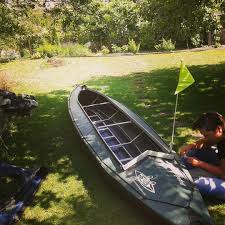So we proceed to assemble the kayak:

1. After choosing the right place, i.e.. clean, equal, not sandy, but preferably grassy - we stretch the rubber coating, and then we sort the parts. To facilitate assembly, we place the selected parts next to the coating, folding them like this, that the bow sections are forward of the shell, and the stern at the rear.
To make the assembly run more efficiently, we mark individual elements properly while still at home, so that everyone has their own landmark, which will make folding easier for us, and thus we will avoid unnecessary searching and running.
2. After assembling the beak part of the skeleton, then the rear part, we introduce the front structure into the bow part of the shell, and then proceed in the same way with the rear part of the structure.
We check, that the bow and stern are properly inserted in the shell, then press down the parts of the raised ladder and turn the caps. In this way, we obtain the exact tension of the fold. In case of any resistance, or if any of the parts are not connected or popped out, we have to loosen the ladder and after the correction we bring them back to their place.
3. We fasten the remaining ribs, paying attention to the marking, we thread the bars into the bearings and connect them with the appropriate bushings for the bow and stern bars.
4. Insert and connect the slat-toe board, and then we put on breakwaters, taking care, that the deck cloth is properly inserted into the breakwater groove.
5. Tighten the bolts of the ribs by inserting the backrests into the breakwater holes. We put the jumper on the front, at the rear, the tailboard and tighten firmly with screws.
6. The remaining steps are to put on the seat, rudder, the helm hoist, steering lines. Finally, we put the apron in the cuts of the toeboard-breakwater.
7. Place the already assembled kayak on the water and attach it to the shore with a mooring line.
Much more trouble, when it comes to transportation, We will get the popular stiff kayak - made of waterproof plywood, "P-36" produced in Poland″, two PTTK (price 2100 PLN) and many other types made by the cottage system.
Rigid kayak made of plywood, canvas cloth, veneer, and more recently plastic, must be sedate, roomy, comfortable.
The skeleton of the above-mentioned kayak consists of side boards, keel, cockpit frames and stringers, bottom and deck made of waterproof materials.
When we go out on the water, we check, does the kayak have: double-blade oars (foldable oars desirable), rudders with links, backrest, ladder, apron, mooring, the flag. If we are thinking of sailing, we also take: sail, links, swords, a drift anchor or ballast, towing cables, and of course a life jacket and a rubber pillow in the cover.
I have mentioned two types of watercraft above, the most frequently used canoeing boats in our waters. Single-folders are also appearing more and more often on tourist routes, crustaceans made of plastic masses and aluminum sheet, and canoes (the so-called. kanu). The latter, despite their great advantages (roomy and comfortable due to the large interior capacity and the possibility of accommodation in a boat).